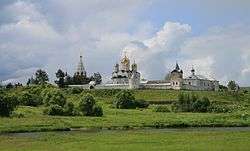Luzhetsky Monastery
|
Panorama of the monastery from the other bank of the river | |
| Monastery information | |
|---|---|
| Full name | Богородице-Рождественский Ферапонтов Лужецкий монастырь |
| Order | Russian Orthodox Church |
| Established | 1408, 1994 |
| Disestablished | 1929 |
| Diocese | Moscow Eparchy |
| People | |
| Founder(s) | Therapont of Belozersk |
| Site | |
| Location | Mozhaysk, Moscow Oblast, Russia |
| Coordinates | Coordinates: 55°31′17″N 36°0′30″E / 55.52139°N 36.00833°E |
| Public access | Yes |
Luzhetsky Monastery (Russian: Богородице-Рождественский Ферапонтов Лужецкий монастырь) is a medieval fortified monastery in Mozhaysk, Moscow Oblast, Russia.[1] It is protected as a cultural monument of federal significance.[2]
The monastery was founded in 1408 by Therapont of Belozersk.[1] Therapont founded Ferapontov Monastery in 1398, located in the Principality of Beloozero, which at the time was administered jointly with the Principality of Mozhaysk. The prince, Andrey of Mozhaysk, resided in Mozhaysk, and was a brother of Vasily, the Grand Prince of Moscow. He was also one of the main sponsors of the monastery. In 1408, he sent a letter to Therapont urging him to come to Mozhaysk, and Therapont was obliged to obey. Even though Therapont, after arriving to Mozhaysk, expressed very clearly his wish to return to White Lake, the prince never let him go. They made a deal, and Therapont founded Luzhetsky Monastery in Mozhaysk. He died in the monastery in 1426.[3] He is venered as a saint by Russian Orthodox Church.
The original cathedral was demolished in the first half of the 16th century, and a five-dome stone cathedral was built in 1524-1547, which still stands today. Mozhaysk, together with the monastery, was transferred to the Grand Duchy of Moscow in the middle of the 16th century. The history of the monastery in the 15th century is somewhat unclear; it is known that in 1523 the hegumen of Luzhetsky Monastery was Makary, who later became the Metropolitan of Moscow.[4] The monastery was considerably damaged during the Time of Troubles in the 1610s, when it was plundered. Most of the current architecture of the monastery, including the bell-tower, the Transfiguration Church, and the cells, were built in the 17th century. In 1812, during the Napoleonic Wars, Luzhetsky monastery was briefly occupied and plundered by the advancing French army. In 1929, it was closed by the Soviets and reopened in 1994.[1]
References
- 1 2 3 "Можайский Лужецкий Ферапонтов монастырь" (in Russian). Government of Moscow Oblast. Retrieved 12 July 2016.
- ↑ Памятники истории и культуры народов Российской Федерации (in Russian). Russian Ministry of Culture. Retrieved 2 June 2016.
- ↑ "Преподобный Ферапонт Белозерский, Можайский. К 550-летию со дня рождения". Журнал Московской Патриархии. Moscow (6). 1976. Retrieved December 3, 2011.
- ↑ "Можайский Лужецкий Рождества Богородицы Ферапонтов мужской монастырь" (in Russian). Official website of Luzhetsky Monastery. Retrieved 15 July 2016.
